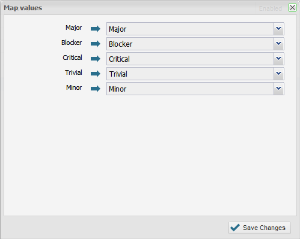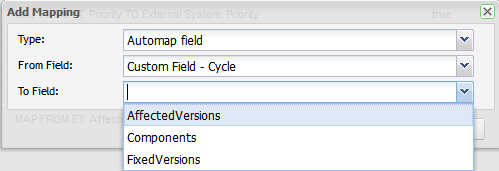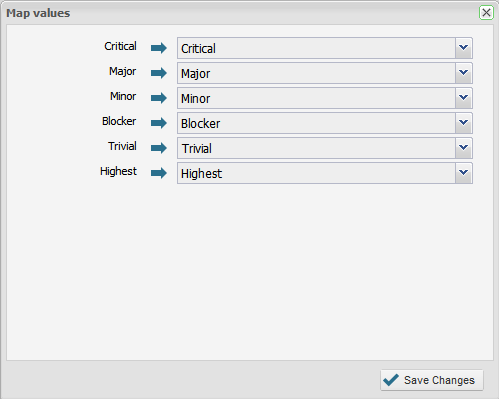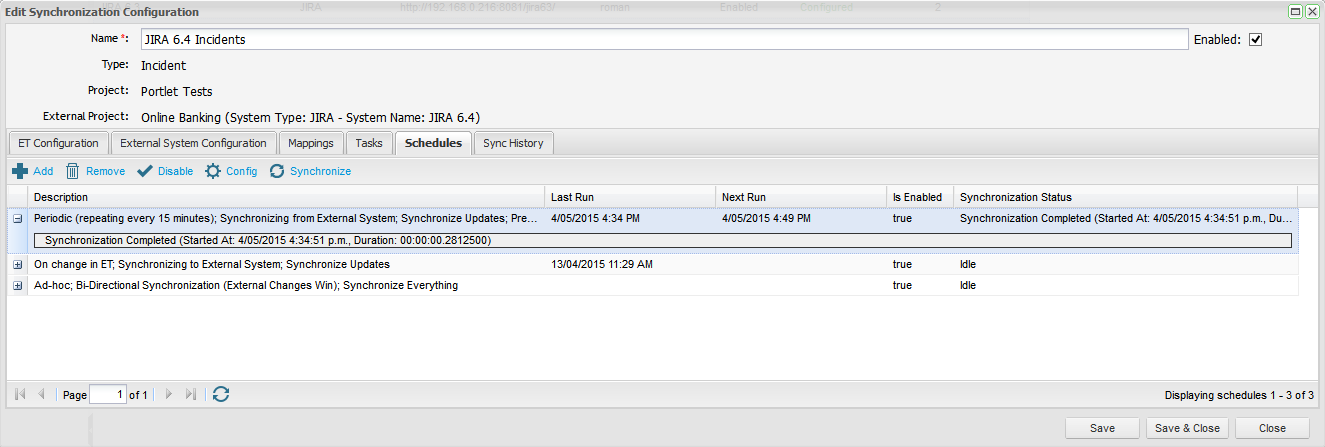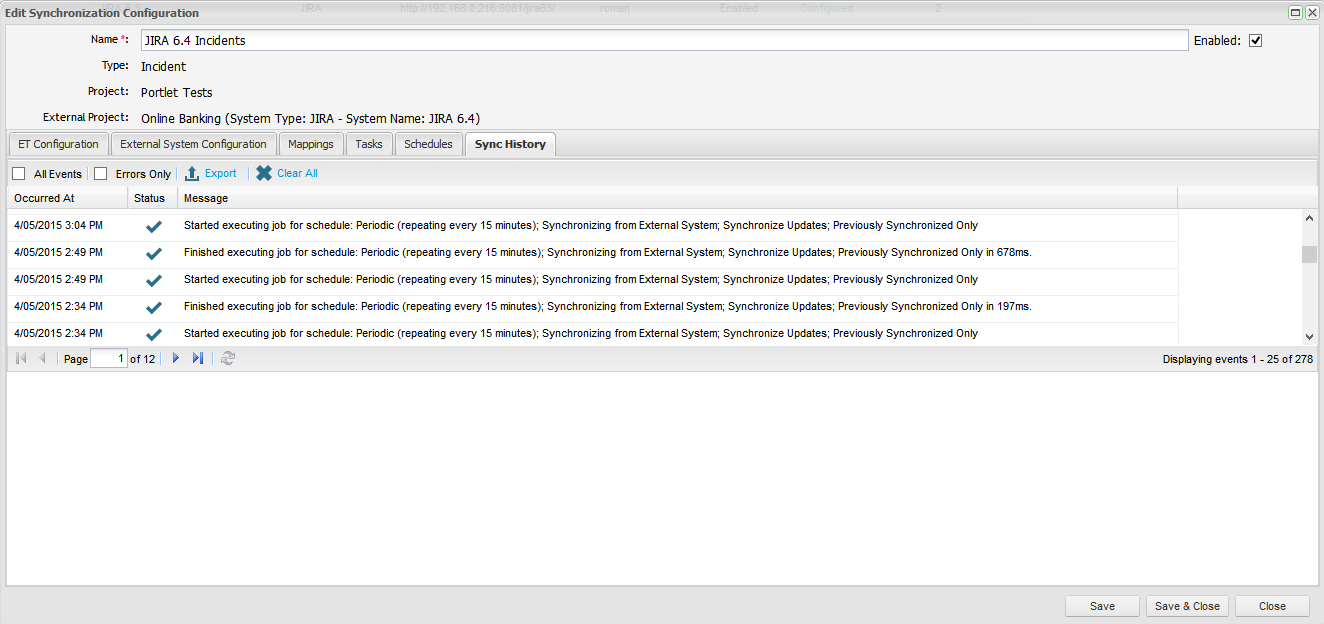...
- In-built field synchronization of: Summary,Type, Status, Priorities, Components, Affects Version(s), Fix Version(s), Assignee, and Comments;
- Configurable synchronization schedule;
- Configurable synchronization direction options: single (Enterprise Tester to JIRA or JIRA to Enterprise Tester) and bi-directional (Enterprise Tester synchronizes first or JIRA synchronizes first)
- Filter options supported for JIRA to Enterprise Tester synchronization, including JQL fragments;
- Custom field support;
- Support for synchronizing picklist (select list) values from JIRA to Enterprise Tester, including JQL fragments;
- JIRA ID on the incident in Enterprise Tester;
- Remote links to the incident in Enterprise Tester and test run added on the JIRA Issue; and
- Full JIRA workflow transition support from Enterprise Tester.
Creating your Project Links to JIRA
Once the JIRA connection has been created (see Configuring Enterprise Tester for JIRA 5.2 and Above), you can begin associating projects in JIRA with projects in Enterprise Tester. Project links can be created and managed either from the Resources tab on your tree view navigator or on the External System Links tab.
External System Links Tab
From the Admin tab, expand Extensions and double click on External Systems. From the External Systems summary grid, double click the External System you wish to create a link to. Then navigate to the Links tab. Click on Add from the tool bar.
...
Once you have completed the screen, click on OK. The External Links Details screen will appear. See the Field Configuration section below.
Resources Tab
From the Resources Tab, click to expand "Project Links". To view all configured links for your project, double click on your project.
...
Once the project link to JIRA has been created, Enterprise Tester will initiate a refresh of all the metadata. This may take a few minutes.
Project Link Configuration
Once you have created the incident project link, the Edit Synchronization Configuration screen will appear.
Enterprise Tester Configuration
There are no options in this section for incident synchronization links because Enterprise Tester will synchronize all incidents created in Enterprise Tester for this project with the JIRA project configured. If you have more than one JIRA project configured to synchronize with this project, you can select which project you wish to synchronize with on the incident screen. You can also choose to synchronize Enterprise Tester incidents with more than one JIRA project provided that you have set up multiple project links.
External System Configuration
If you are synchronizing incidents created in JIRA to Enterprise Tester, you can specify criteria to filter the incidents that will be selected for synchronization.
...
| Info | ||
|---|---|---|
| ||
When using JQL fragments as part of your query criteria, the additional filter criteria you have selected will be added. Enterprise Tester already specifies the JIRA project in the filter parameters based on the project you are syncing your Enterprise Tester project with. If you find that you the issues being synchronized are not what you expected, it is worth testing your JQL fragment in JIRA. |
| Anchor | ||||
|---|---|---|---|---|
|
When a project link is created a refresh lookups kicks off. This process finds all the JIRA field values for your project to populate the picklist (select list) for this screen. If you do not see any JIRA values in the drop down list or an incomplete list is presented, click on Refresh Lookups to update the picklist values.
Field Configuration — Mappings
On the mappings tab, the Synchronize Entities option is pre-selected. The selection of this option will ensure that incident and tasks are synchronized. If the Synchronize Entities is not selected, then only the Tasks will run. See the Task section for more detail.
...
• One tab for mapping fields from Enterprise Tester to the external system (JIRA).
• One tab for mapping fields from the external system (JIRA) to Enterprise Tester
Enterprise Tester to JIRA Mappings
The next step is to configure Enterprise Tester inbuilt fields to JIRA fields. On the Enterprise Tester to External System Tab, there are four activities that are set to run on Synchronization of an incident:
...
To complete the field mappings, click on the field row and select Edit from the tool bar.
Complete mapping Enterprise Tester field values to JIRA field values. Where picklist values in Enterprise Tester and JIRA are exact matches, the mappings will be automatically configured.
Click Save Changes.
Complete mapping field values for all fields following steps 1-3.
JIRA to Enterprise Tester Mappings
The next step is to configure JIRA to Enterprise Tester field mappings. On the External System to Enterprise Tester tab, there are also four activities that are set to run on Synchronization of an incident:
...
The Automap field type mappings are also already configured. The Automap field type will update the Enterprise Tester field picklist with new values from JIRA when they are detected on a incident that is being synchronized from JIRA. Note that this feature does not update all new picklist values that have been added to JIRA but only those that have been detected on an incident that is being synchronized. See the Task section below for more information about automatically updating your picklist values from JIRA.
Automap Field – Automap from External System: Type to Enterprise Tester: Type
Automap Field – Automap from External System: Priority to Enterprise Tester: Priority
Automap – Automap from External System: Status to Enterprise Tester: Status
Automap – Automap from External System: Resolution to Enterprise Tester: Resolution
Automap – Automap from External System: Components to Enterprise Tester: Components
Automap – Automap from External System: Fixed Versions to Enterprise Tester: Fixed Versions
Automap – Automap from External System: Affected Versions to Enterprise Tester: Affected Versions
Adding New Field Mappings — Configuring Custom Fields
Custom Fields can be synchronized from Enterprise Tester. A little set up is required to selected and configure the fields that you wish to synchronize.
...
| Type | Description |
|---|---|
Automap Field | Automap Field mapping will automatically map all matching field values in Enterprise Tester and JIRA so that it is not necessary to do this manually. In addition when synchronizing in the JIRA to Enterprise Tester direction, new field values detected on synchronize from your external system (JIRA) will be added to the Enterprise Tester field value picklist if they don't already exist. Using this type of field mapping eliminates duplicate field management in JIRA and in Enterprise Tester. It will also allow incident synchronization to complete even when map values already exist. This type of mapping is useful for fields like Versions and Components which tend to continually grow. This type of mapping should be used when your picklist values in Enterprise Tester and JIRA are the same. Supported field types include, Combo box (select lists), multiselect list, radio button groups and checkbox groups. *Note: that this feature does not synchronize the picklists between JIRA and Enterprise Tester but it does add values to the Enterprise Tester picklists when new values are detected on incidents during synchronization. |
Copy Field | Copy field will copy the text from your JIRA issue to the mapped field in Enterprise Tester. This is recommended when synchronizing text fields. |
Set Field to Value | Set field to value field mapping allows you to specify a value to populate the field in Enterprise Tester with regardless of the values in JIRA. All Field types are supported. |
Set Field to Value (if it's null or empty) | Set field value field mapping allows you to specify a value to populate the field in Enterprise Tester with, if the field does not currently have a value set/is null. All Field Types are supported. This mapping type is useful for setting a default value, if the value was not populated by a previous mapping (and so when used in this way, the mapping should appear at the bottom of the list of field mappings). |
Map Field | The Map field option allows you to manually map the field values in Enterprise Tester with those of JIRA. This is useful when your your picklist values in JIRA are different to your picklist values in Enterprise Tester. Enterprise Tester will automatically map any exact value matches when first displaying the mapping configuration screen. Supported field types include: Combo box (select lists), multiselect list, radio button groups and checkbox groups. |
Automap
When configuring an Automap Type field, you will only need to select the JIRA and Enterprise Tester fields that you are mapping. Auto mapping should be used when your Enterprise Tester and JIRA picklist values are exactly the same, it will automatically map the exact matching values and when Synchronizing in the Enterprise Tester to JIRA direction it will also add new values detected from JIRA to your Enterprise Tester picklist.
Copy
When configuring a Copy Field Type field, you will only need to select the JIRA and Enterprise Tester fields that you are mapping. The text or value from the source incident will be copied to the incident in the other system.
Set Field to Value
On synchronization you can set a value for a field to a specified value. You only need to specify the field in Enterprise Tester and the the value you would like to set.
Set Field Value to (if null or empty)
If the field value is null or empty can you set the field to be set to a specified value. For this configuration select the field and the value to set.
Map
When using the map field configuration, you will be required to manually map the field values. This is useful when the values in Enterprise Tester and JIRA are different or if you have more that one value that will map to the same value in the other system.
To complete this configuration, you will need to choose Enterprise Tester and JIRA fields whose values will be synchronized and then you will need to complete mapping any values that do not exist in the system that you are synchronizing to. All values that have exact matches in both systems will automatically be mapped.
Notes on Field Type Support for Automap and Map Mapping Types
The following field types from JIRA are not supported by the automap or map mapping types:
...
Another point to note when configuring your field mapping configuration for "Automap" or "Map" type mappings is that you may need at least one value in your JIRA picklist (configurable set of allowable values) for the field (drop down list, checkbox list etc.) for the field to be detected as a configurable field for these mapping types. After adding your value(s) to JIRA you may need to perform a refresh lookups before the field will be detected.
| Anchor | ||||
|---|---|---|---|---|
|
In addition to synchronizing requirements and incidents between JIRA and Enterprise Tester you can also set up tasks to synchronize picklist field values. A good example of when this would be useful are the fields Versions and Components.
...
From the grid you can see that you are able to configure or disable/enable each task.
Scheduling Synchronization
Now that your configuration and field mappings are complete you are ready to synchronize. By default, for incidents, the following schedules are pre-configured.
...
You can use the tool bar to add a new scheduled synchronization, delete an existing configuration, enable or disable an existing schedule, configure an existing schedule or manually initiate a synchronization.
Synchronization History
You can view the synchronization history from both the synchronization configuration screen and the individual synchronized entities. From the configuration screen you can view all synchronization events, select to only view errors, export the synchronization events to a .CSV file or clear the history.
Deleting Project Links
Deleting project links will stop the synchronization between Enterprise Tester and your external system. When deleting the link you will have the option to delete the link and remove all external link references or to retain these references.
If you delete and elect to "keep references" then previously synchronized entities will still list the remote entities (JIRA issues/TFS work items) that they have been synchronized to, in their remote links list.
| Note |
|---|
Even if you chose to remove references, this will only apply to Enterprise Tester, JIRA issues will still contain trackback links and remote links referring the Enterprise Tester entity they were synchronized with. This information must be removed manually. |
Limitations
When synchronizing from JIRA to Enterprise Tester, links between issues in JIRA are not synchronized to relationships in Enterprise Tester.
Auto-map from Enterprise Tester to JIRA is only supported for the component and version fields, and its use is generally discouraged (adding versions and components to your defect tracker generally makes more sense, so that you can populate additional information such as component lead, due date etc. — which Enterprise Tester does not support).
...
